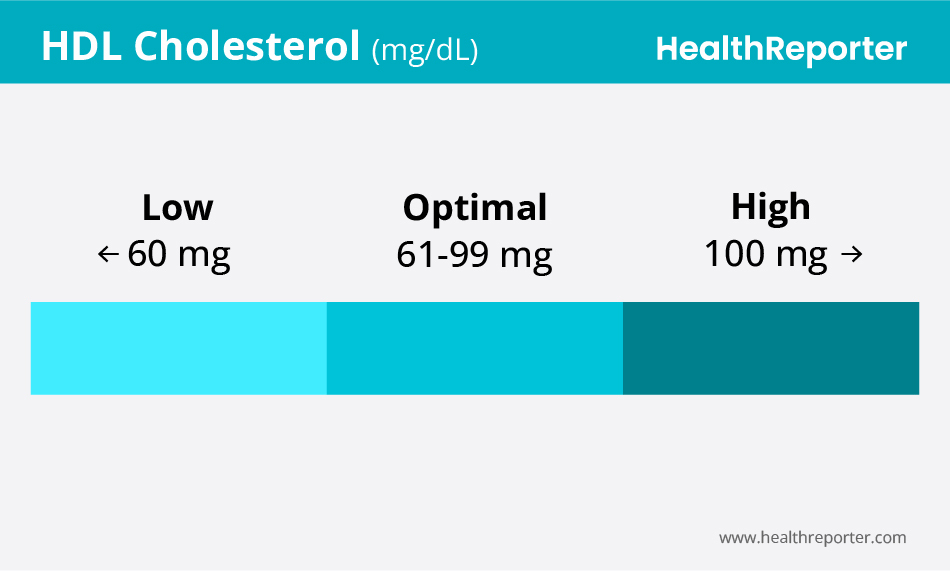HDL Cholesterol Level Chart: Symptoms and Causes

We’re constantly being told that high cholesterol levels are bad for you, but did you know that there are two kinds of cholesterol, and one of them isn’t bad for you at all? HDL cholesterol is sometimes called the “good” cholesterol and can support better heart health, but what actually is it?
In this guide, we’re going to take a look at what HDL cholesterol levels mean, what good, bad, and normal cholesterol levels tend to look like, and how to boost this good blood cholesterol. Take a look now to find out more.
What Is HDL Cholesterol?
HDL cholesterol is known as the good kind of cholesterol and makes up one-half of your total cholesterol levels. HDL cholesterol, or high-density lipoprotein, helps the body reduce LDL cholesterol levels by absorbing it and sending it back to the liver to be flushed from the body.
LDL cholesterol, or low-density lipoprotein, is the bad kind of cholesterol. Having too much of this bad cholesterol in your blood can lead to cholesterol buildup in the blood vessels. This buildup is known as plaque and can put you at an increased risk of heart disease and stroke.
Your blood cholesterol levels are affected by tons of different risk factors, including your intake of saturated fats, your body weight, and metabolic conditions like diabetes, genetics, sex, and age. High blood cholesterol levels tend to be seen as a bad sign, but high HDL levels can actually support better heart health and reduce your risk of heart disease and other cardiovascular diseases.
HDL Level Chart
An HDL level test shows your cholesterol levels to help determine if your LDL cholesterol levels or HDL levels are in balance. An HDL level test measures how much of the good kind of cholesterol you’ve got.
Below, we’ve summarized what the cholesterol level chart results indicate after an HDL test.

Low (<60mg/dL)
Low levels of HDL are anything under 60mg/dL, but they can vary depending on your age and sex. For example, low HDL for men is between 40mg/dL and 60mg/dL, whereas for women, it is 50mg/dL to 60mg/dL.
Symptoms and risks
While there are no obvious symptoms associated with having low levels of good cholesterol in your blood, having higher LDL cholesterol and lower HDL increases your risk of many health complications. These include stroke, heart attack, heart disease, and sudden cardiac arrest.
If you have early onset coronary artery disease (meaning you are diagnosed before the age of 55 as a man or 65 as a woman), this could be indicative of very low HDL in your total cholesterol levels. Peripheral polyneuropathy is also a common complication in patients with diabetes and is associated with low HDL.
Causes
There are many causes of low HDL in your total cholesterol levels. These include smoking, a diet high in refined carbs, and not getting enough physical activity. Changing your diet and increasing your physical activity levels are thought to help improve total cholesterol levels and mitigate the risks caused by high cholesterol.
Lifestyle changes, like getting more cardio exercise each week and changing your diet, can help boost HDL in your blood. If you have diabetes, you could also try speaking with your doctor about better management techniques and using a diabetes management app.
Optimal (61–99mg/dL)
The optimal range in an HDL blood test is between 61mg/dL and 99mg/dL. These optimal levels are thought to reduce risks of cardiovascular conditions, like heart disease. Some people naturally have higher HDL blood levels, whereas others need to change their diet and lifestyle to alter the composition of their total cholesterol.
Benefits
The benefit of having optimal levels of HDL in your blood is that this kind of cholesterol helps to keep your LDL levels down. High-density lipoproteins absorb low-density lipoproteins and transport them to the liver to be removed from your body.
Since higher total and LDL cholesterol put you at higher risk of heart attack or stroke and other cardiovascular problems, having the optimal levels of HDL in your system means you are more protected from these conditions and from plaque buildup in the arteries.
Causes
Eating the right kind of diet that is low in refined carbs, saturated, and trans fats can help improve HDL in your blood and cardiovascular disease control. Being active can also support it, as can not smoking.
There are also people who are more genetically predisposed to having higher levels of HDL, and age and gender also play a role.
High (100<mg/dL)
Strangely, people with high levels of HDL, meaning anything over 100mg/dL, are more at risk of developing heart disease and other cardiovascular conditions, like a heart attack, too. Though bad cholesterol is usually thought to be the cause of this, it is possible for HDL to become so high it loses its protective benefits.
Risks
While there isn’t a lot of research, there is some evidence that having high levels of HDL in your blood may be too much cholesterol – even if it is the good kind. There is concern that extremely high levels of HDL may actually increase the risk of heart disease and other cardiovascular conditions, just as low levels do.
Causes
As with all high cholesterol results, having too much HDL in your blood tends to be because of your diet and lifestyle. There are also some links between extremely high HDL and menopause, as well as illness and inflammation.
How to Boost HDL Cholesterol Levels
- Exercising for at least 30 minutes per day, five times a week – This could include cardio exercises, a gym class, or just a regular morning walk.
- Eating a more balanced and healthy diet – This means eating enough fiber, or adding a fiber supplement to your diet to increase your intake, reducing your saturated and trans fat intake, and eating more whole and healthy foods.
- Losing any excess weight
- Quitting smoking
- Ensuring that you manage stress levels properly
- Getting enough quality sleep each night
How Often Should I Measure My Cholesterol Levels?
A cholesterol test can be done for anyone, and it is recommended that healthy adults get it done at least every 4–6 years. Children and teens can get their cholesterol checked between ages 9 and 11 and then again between ages 17 and 21.
There are some people who should get their cholesterol levels checked more often, including people who have a family history of high cholesterol, those diagnosed with familial hypercholesterolemia, people with heart disease and diabetes, and children who have obesity or diabetes.
Track Your HDL Cholesterol Levels
You can track your levels of HDL by getting regular tests and using apps like the Cardi Health app. This app helps to educate users about heart health, including the dangers of high cholesterol levels.
It offers user education based on their answers to the preliminary quiz and is condition-specific. It uses gamification to help users better their heart health and want to achieve more. The app also shows users their health metrics over long periods of time and uses advanced tracking data to give them the most helpful insights possible.
The Cardi Health app helps users manage their nutrition and get more exercise daily to boost their heart health. It provides a space to track your medication and comes with other devices, like blood pressure monitors, for at-home readings.
FAQs
For men, an HDL level of 60mg/dL or above is desirable. Anything below this number puts you at risk of heart problems, like a heart attack.
For women, an HDL level of 60mg/dL is optimal. Anything lower than 50mg/dL can put you at a higher risk of developing cardiovascular problems.
The NIH suggests that for anyone under the age of 19, an HDL level of more than 45mg/dL is considered healthy.
A Word From Our MD
High cholesterol is considered a bad thing, but there are two kinds of cholesterol: LDL and HDL. While LDL cholesterol can cause havoc for your heart health, HDL actually helps to absorb and expel LDL from your body, helping to protect you.
High levels of LDL can cause plaque buildup in the blood vessels. This plaque causes all sorts of problems, including heart attacks, sudden cardiac arrest, stroke, and many other cardiovascular diseases. HDL absorbs LDL in your body and removes it from your body, so HDL is a protective form of cholesterol.
While having high cholesterol levels of HDL is good for you, and healthy adults should have around 60mg/dL and above, there is evidence that having too high levels of HDL can be bad for you too.
The best thing to do for your cholesterol levels is to eat a healthy diet filled with fiber, whole and unrefined carbs, lean protein, and healthy fats, get enough exercise, sleep properly, and manage stress. You should also get your cholesterol levels tested every 4–6 years.
If you have high cholesterol, your doctor may also prescribe cholesterol-lowering drugs alongside advice for lifestyle changes.
Conclusion
An HDL test is done to measure cholesterol levels. HDL is a good kind of cholesterol and can help lower LDL cholesterol levels. The cholesterol in your blood is affected by everything from your lifestyle to your age and genetics, but there are some things you can do to lower it yourself.
If you’re looking into lowering cholesterol, try making dietary changes, increasing exercise, and trying an app designed to promote heart health, like the Cardi Health app.
- Personalized activity plan to suit the user
- Personalized nutrition plan
- Takes into account dietary requirements, preferences, and allergies
- Action plans generated from the tracking tool
- Real-time insights into your heart’s health performance

















































 Select your language:
Select your language: 



